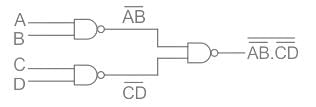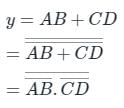GATE Exam > GATE Questions > The Boolean function Y = AB + CD is to be rea...
Start Learning for Free
The Boolean function Y = AB + CD is to be realized using only 2 input NAND gates. The minimum number of gates required is
- a)2
- b)3
- c)4
- d)5
Correct answer is option 'B'. Can you explain this answer?
Most Upvoted Answer
The Boolean function Y = AB + CD is to be realized using only 2 input ...
Explanation:
To implement the Boolean function Y = AB CD using only 2-input NAND gates, we can follow the below steps:
Step 1: Draw the truth table for the given Boolean function.
A | B | C | D | Y
--|---|---|---|--
0 | 0 | 0 | 0 | 0
0 | 0 | 0 | 1 | 0
0 | 0 | 1 | 0 | 0
0 | 0 | 1 | 1 | 0
0 | 1 | 0 | 0 | 0
0 | 1 | 0 | 1 | 0
0 | 1 | 1 | 0 | 0
0 | 1 | 1 | 1 | 0
1 | 0 | 0 | 0 | 0
1 | 0 | 0 | 1 | 0
1 | 0 | 1 | 0 | 0
1 | 0 | 1 | 1 | 0
1 | 1 | 0 | 0 | 1
1 | 1 | 0 | 1 | 0
1 | 1 | 1 | 0 | 0
1 | 1 | 1 | 1 | 1
Step 2: From the truth table, we can see that the output Y is equal to 1 only when A = 1, B = 1, C = 0, and D = 0. So, we need to implement this condition using only 2-input NAND gates.
Step 3: We can use the De Morgan's theorem to simplify the expression for Y.
Y = AB CD
= (A' + B') + (C' + D')
= [(A' + B') (C' + D')]'
Step 4: We can implement the simplified expression using 3 NAND gates as shown below.
```
A B C D
| | | |
NAND NAND NAND NAND
| | | |
NAND--NAND--NAND--|
| | | |
| | | NAND
| | | |
| | NAND---NAND
| | | |
NAND---NAND---NAND--|
| | | |
| | | NAND
| | | |
| | NAND---NAND
| | | |
NAND---NAND--NAND--|
| | | |
| | | NAND
| | | |
NAND---NAND---NAND--Y
```
Therefore, the minimum number of gates required to realize the Boolean function Y = AB CD using only 2-input NAND gates is 3. Hence, option B is the correct answer.
To implement the Boolean function Y = AB CD using only 2-input NAND gates, we can follow the below steps:
Step 1: Draw the truth table for the given Boolean function.
A | B | C | D | Y
--|---|---|---|--
0 | 0 | 0 | 0 | 0
0 | 0 | 0 | 1 | 0
0 | 0 | 1 | 0 | 0
0 | 0 | 1 | 1 | 0
0 | 1 | 0 | 0 | 0
0 | 1 | 0 | 1 | 0
0 | 1 | 1 | 0 | 0
0 | 1 | 1 | 1 | 0
1 | 0 | 0 | 0 | 0
1 | 0 | 0 | 1 | 0
1 | 0 | 1 | 0 | 0
1 | 0 | 1 | 1 | 0
1 | 1 | 0 | 0 | 1
1 | 1 | 0 | 1 | 0
1 | 1 | 1 | 0 | 0
1 | 1 | 1 | 1 | 1
Step 2: From the truth table, we can see that the output Y is equal to 1 only when A = 1, B = 1, C = 0, and D = 0. So, we need to implement this condition using only 2-input NAND gates.
Step 3: We can use the De Morgan's theorem to simplify the expression for Y.
Y = AB CD
= (A' + B') + (C' + D')
= [(A' + B') (C' + D')]'
Step 4: We can implement the simplified expression using 3 NAND gates as shown below.
```
A B C D
| | | |
NAND NAND NAND NAND
| | | |
NAND--NAND--NAND--|
| | | |
| | | NAND
| | | |
| | NAND---NAND
| | | |
NAND---NAND---NAND--|
| | | |
| | | NAND
| | | |
| | NAND---NAND
| | | |
NAND---NAND--NAND--|
| | | |
| | | NAND
| | | |
NAND---NAND---NAND--Y
```
Therefore, the minimum number of gates required to realize the Boolean function Y = AB CD using only 2-input NAND gates is 3. Hence, option B is the correct answer.
Free Test
FREE
| Start Free Test |
Community Answer
The Boolean function Y = AB + CD is to be realized using only 2 input ...
Concept:
De Morgan’s law states that:

Analysis:


Only 3 NAND gates are required
De Morgan’s law states that:

Analysis:


Only 3 NAND gates are required

|
Explore Courses for GATE exam
|

|
Question Description
The Boolean function Y = AB + CD is to be realized using only 2 input NAND gates. The minimum number of gates required isa)2b)3c)4d)5Correct answer is option 'B'. Can you explain this answer? for GATE 2025 is part of GATE preparation. The Question and answers have been prepared according to the GATE exam syllabus. Information about The Boolean function Y = AB + CD is to be realized using only 2 input NAND gates. The minimum number of gates required isa)2b)3c)4d)5Correct answer is option 'B'. Can you explain this answer? covers all topics & solutions for GATE 2025 Exam. Find important definitions, questions, meanings, examples, exercises and tests below for The Boolean function Y = AB + CD is to be realized using only 2 input NAND gates. The minimum number of gates required isa)2b)3c)4d)5Correct answer is option 'B'. Can you explain this answer?.
The Boolean function Y = AB + CD is to be realized using only 2 input NAND gates. The minimum number of gates required isa)2b)3c)4d)5Correct answer is option 'B'. Can you explain this answer? for GATE 2025 is part of GATE preparation. The Question and answers have been prepared according to the GATE exam syllabus. Information about The Boolean function Y = AB + CD is to be realized using only 2 input NAND gates. The minimum number of gates required isa)2b)3c)4d)5Correct answer is option 'B'. Can you explain this answer? covers all topics & solutions for GATE 2025 Exam. Find important definitions, questions, meanings, examples, exercises and tests below for The Boolean function Y = AB + CD is to be realized using only 2 input NAND gates. The minimum number of gates required isa)2b)3c)4d)5Correct answer is option 'B'. Can you explain this answer?.
Solutions for The Boolean function Y = AB + CD is to be realized using only 2 input NAND gates. The minimum number of gates required isa)2b)3c)4d)5Correct answer is option 'B'. Can you explain this answer? in English & in Hindi are available as part of our courses for GATE.
Download more important topics, notes, lectures and mock test series for GATE Exam by signing up for free.
Here you can find the meaning of The Boolean function Y = AB + CD is to be realized using only 2 input NAND gates. The minimum number of gates required isa)2b)3c)4d)5Correct answer is option 'B'. Can you explain this answer? defined & explained in the simplest way possible. Besides giving the explanation of
The Boolean function Y = AB + CD is to be realized using only 2 input NAND gates. The minimum number of gates required isa)2b)3c)4d)5Correct answer is option 'B'. Can you explain this answer?, a detailed solution for The Boolean function Y = AB + CD is to be realized using only 2 input NAND gates. The minimum number of gates required isa)2b)3c)4d)5Correct answer is option 'B'. Can you explain this answer? has been provided alongside types of The Boolean function Y = AB + CD is to be realized using only 2 input NAND gates. The minimum number of gates required isa)2b)3c)4d)5Correct answer is option 'B'. Can you explain this answer? theory, EduRev gives you an
ample number of questions to practice The Boolean function Y = AB + CD is to be realized using only 2 input NAND gates. The minimum number of gates required isa)2b)3c)4d)5Correct answer is option 'B'. Can you explain this answer? tests, examples and also practice GATE tests.

|
Explore Courses for GATE exam
|

|
Signup for Free!
Signup to see your scores go up within 7 days! Learn & Practice with 1000+ FREE Notes, Videos & Tests.























